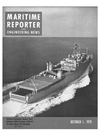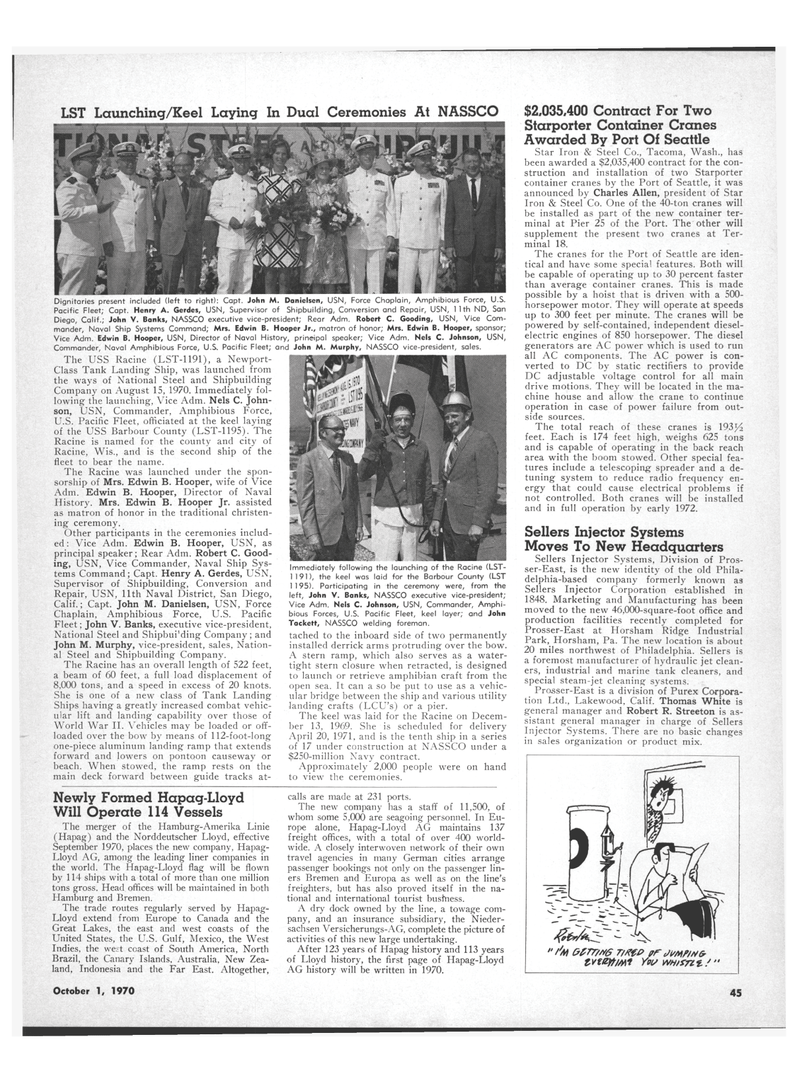
Page 43: of Maritime Reporter Magazine (October 1970)
Read this page in Pdf, Flash or Html5 edition of October 1970 Maritime Reporter Magazine
LST Launching/Keel Laying In Dual Ceremonies At NASSCO
Dignitaries present included (left to right): Capt. John M. Danielsen, USN, Force Choplain, Amphibious Force, U.S.
Pacific Fleet; Capt. Henry A. Gerdes, USN, Supervisor of Shipbuilding, Conversion and Repair, USN, 11th ND, San
Diego, Calif.; John V. Banks, NASSCO executive vice-president; Rear Adm. Robert C. Gooding, USN, Vice Com- mander, Naval Ship Systems Command; Mrs. Edwin B. Hooper Jr., matron of honor; Mrs. Edwin B. Hooper, sponsor-
Vice Adm. Edwin B. Hooper, USN, Director of Naval History, principal speaker; Vice Adm. Nels C. Johnson, USN,
Commander, Naval Amphibious Force, U.S. Pacific Fleet; and John M. Murphy, NASSCO vice-president, sales.
The USS Racine (LST-1191), a Newport-
Class Tank Landing Ship, was launched from the ways of National Steel and Shipbuilding
Company on August 15, 1970. Immediately fol- lowing the launching, Vice Adm. Nels C. John- son, USN, Commander, Amphibious Force,
U.S. Pacific Fleet, officiated at the keel laying of the USS Barbour County (LST-1195). The
Racine is named for the county and city of
Racine, Wis., and is the second ship of the fleet to bear the name.
The Racine was launched under the spon- sorship of Mrs. Edwin B. Hooper, wife of Vice
Adm. Edwin B. Hooper, Director of Naval
History. Mrs. Edwin B. Hooper Jr. assisted as matron of honor in the traditional christen-
Immediately following the launching of the Racine (LST- 1191), the keel was laid for the Barbour County (LST 1 195). Participating in the ceremony were, from the left, John V. Banks, NASSCO executive vice-president;
Vice Adm. Nels C. Johnson, USN, Commander, Amphi- bious Forces, U.S. Pacific Fleet, keel layer; and John
Tockett, NASSCO welding foreman. tached to the inboard side of two permanently installed derrick arms protruding over the bow.
A stern ramp, which also serves as a water- tight stern closure when retracted, is designed to launch or retrieve amphibian craft from the open sea. It can a so be put to use as a vehic- ular bridge between the ship and various utility landing crafts (LCU's) or a pier.
The keel was laid for the Racine on Decem- ber 13, 1969. She is scheduled for delivery
April 20, 1971, and is the tenth ship in a series of 17 under construction at NASSCO under a $250-million Navy contract.
Approximately 2,000 people were on hand to view the ceremonies. ing ceremony.
Other participants in the ceremonies includ- ed : Vice Adm. Edwin B. Hooper, USN, as principal speaker; Rear Adm. Robert C. Good- ing, USN, Vice Commander, Naval Ship Sys- tems Command; Capt. Henry A. Gerdes, USN,
Supervisor of Shipbuilding, Conversion and
Repair, USN, 11th Naval District, San Diego,
Calif.; Capt. John M. Danielsen, USN, Force
Chaplain, Amphibious Force, U.S. Pacific
Fleet; John V. Banks, executive vice-president,
National Steel and Shipbui'ding Company; and
John M. Murphy, vice-president, sales, Nation- al Steel and Shipbuilding Company.
The Racine has an overall length of 522 feet, a beam of 60 feet, a full load displacement of 8,000 tons, and a speed in excess of 20 knots.
She is one of a new class of Tank Landing
Ships having a greatly increased combat vehic- ular lift and landing capability over those of
World War II. Vehicles may be loaded or off- loaded over the bow by means of 112-foot-long one-piece aluminum landing ramp that extends forward and lowers on pontoon causeway or beach. When stowed, the ramp rests on the main deck forwrard between guide tracks at-
Newly Formed Hapag-Lloyd
Will Operate 114 Vessels
The merger of the Hamburg-Amerika Linie (Hapag) and the Norddeutscher Lloyd, effective
September 1970, places the new company, Hapag-
Lloyd AG, among the leading liner companies in the world. The Hapag-Lloyd flag will be flown by 114 ships with a total of more than one million tons gross. Head offices will be maintained in both
Hamburg and Bremen.
The trade routes regularly served by Hapag-
Lloyd extend from Europe to Canada and the
Great Lakes, the east and west coasts of the
United States, the U.S. Gulf, Mexico, the West
Indies, the west coast of South America, North
Brazil, the Canary Islands, Australia, New Zea- land, Indonesia and the Far East. Altogether, calls are made at 231 ports.
The new company has a staff of 11,500, of whom some 5,000 are seagoing personnel. In Eu- rope alone, Hapag-Lloyd AG maintains 137 freight offices, with a total of over 400 world- wide. A closely interwoven network of their own travel agencies in many German cities arrange passenger bookings not only on the passenger lin- ers Bremen and Europa as well as on the line's freighters, but has also proved itself in the na- tional and international tourist busfness.
A dry dock owned by the line, a towage com- pany, and an insurance subsidiary, the Nieder- sachsen Versicherungs-AG, complete the picture of activities of this new large undertaking.
After 123 years of Hapag history and 113 years of Lloyd history, the first page of Hapag-Lloyd
AG history will be written in 1970. $2,035,400 Contract For Two
Starporter Container Cranes
Awarded By Port Of Seattle
Star Iron & Steel Co., Tacoma, Wash., has been awarded a $2,035,400 contract for the con- struction and installation of two Starporter container cranes by the Port of Seattle, it was announced by Charles Allen, president of Star
Iron & Steel Co. One of the 40-ton cranes will be installed as part of the new container ter- minal at Pier 25 of the Port. The other will supplement the present two cranes at Ter- minal 18.
The cranes for the Port of Seattle are iden- tical and have some special features. Both will be capable of operating up to 30 percent faster than average container cranes. This is made possible by a hoist that is driven with a 500- horsepower motor. They will operate at speeds up to 300 feet per minute. The cranes will be powered by self-contained, independent diesel- electric engines of 850 horsepower. The diesel generators are AC power which is used to run all AC components. The AC power is con- verted to DC by static rectifiers to provide
DC adjustable voltage control for all main drive motions. They will be located in the ma- chine house and allow the crane to continue operation in case of power failure from out- side sources.
The total reach of these cranes is 193^ feet. Each is 174 feet high, weighs 625 tons and is capable of operating in the back reach area with the boom stowed. Other special fea- tures include a telescoping spreader and a de- tuning system to reduce radio frequency en- ergy that could cause electrical problems if not controlled. Both cranes will be installed and in full operation by early 1972.
Sellers Injector Systems
Moves To New Headguarters
Sellers Injector Systems, Division of Pros- ser-East, is the new identity of the old Phila- delphia-based company formerly known as
Sellers Injector Corporation established in 1848. Marketing and Manufacturing has been moved to the new 46,000-square-foot office and production facilities recently completed for
Prosser-East at Horsham Ridge Industrial
Park, Horsham, Pa. The new location is about 20 miles northwest of Philadelphia. Sellers is a foremost manufacturer of hydraulic jet clean- ers, industrial and marine tank cleaners, and special steam-jet cleaning systems.
Prosser-East is a division of Purex Corpora- tion Ltd., Lakewood, Calif. Thomas White is general manager and Robert R. Streeton is as- sistant general manager in charge of Sellers
Injector Systems. There are no basic changes in sales organization or product mix. " /'M Gfrr/HG T/WP pr jmr/NG' tVWftmt YOU WH/fTlf. / "
October T, 1970 45

 42
42

 44
44
